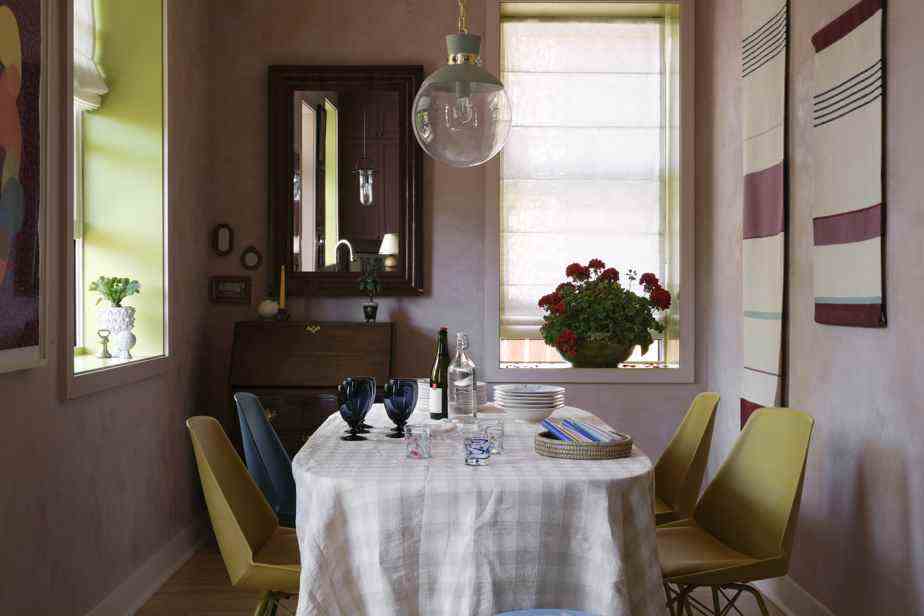Used since Antiquity, lime plasters are part of an ancestral know-how and a heritage that ties in with a very current desire for authenticity. Played from floor to ceiling or as accents, they come back to dress up the decor and leave their enveloping imprint.
The Colosseum in Rome and the Pantheon were erected with lime-based mortar. The painter Michelangelo used it as a canvas for his monumental fresco in the Sistine Chapel. Widespread in old constructions in Europe, it is more exceptional here. The lime nevertheless left its mark on heritage homes along the St. Lawrence.
We are now rediscovering this natural and durable material in the revitalization of old constructions and integrated into contemporary architecture.
Lime is a derivative of liquefied limestone which acts as a binder and is associated with pigments and aggregates such as marble powder, sand or pumice stone. Since it hardens slowly, it can be worked with a brush or trowel to create different whitewashes and textures that become stone again once set, explains painter-decorator Carole Hili.

PHOTO PROVIDED BY TOCKAY
Tadelakt made by Tockay
In its fluid form, lime can be compared to a very matt, but completely natural paint. More consistent, it creates finishes from the roughest to the finest — rough, polished or even mirrored — depending on the recipe and technique used. Traditionally present in hammams, tadelakt is a technique in itself found in showers and other surfaces exposed to water.
A natural finish
After years of working in Europe, Carole Hili started Tockay in Quebec with the idea of offering healthy alternatives to conventional building coatings. “Lime is biodegradable and could potentially be composted,” she says. As its pH is very high, it is also antifungal and antibacterial, which explains why it has traditionally been used to disinfect. Added to these hygienic considerations are antistatic and dustproof properties, as well as low sound and thermal conductivity.
Most surfaces can accommodate a lime plaster. However, the support must be prepared accordingly and according to its use. As it is porous in its raw state, lime stains easily. It is sealed with wax or Marseille soap on a kitchen backsplash or in a very busy room.
-

PHOTO PROVIDED BY ATELIER BARDA
Atelier Barda project, produced by Du Chanvre
-

PHOTO PROVIDED BY VENOSA INTERIORS
Classic plaster by Venosa Interiors
-

PHOTO PROVIDED BY TOCKAY
Tadelakt by Tockay
-

PHOTO PROVIDED BY HEMP
Classic coating by Du Chanvre
-

PHOTO PROVIDED BY ATELIER BARDA
Atelier Barda project
1/5
Accessible to the amateur? It all depends on the complexity of the job. Certain whitewashes, and imperatively tadelakt, used where there is a risk of infiltration, benefit from being carried out by professionals. The cost of a lime application by a skilled tradesman fluctuates widely depending on the volume and the technique employed, and therefore can range from $6 to over $120 per square foot.
A moving material
“The result has something artisanal, natural about it. We feel the hand of the craftsman, describes Anthony Néron, whose workshop has made sustainable materials its specialty. It’s a bit like comparing a vinyl handbag to a leather one; the result is the same, but the feeling is different. With lime, you get something organic in a truer setting,” says the founder of Du Chanvre.

PHOTO PROVIDED BY HEMP
The craftsman Anthony Néron, founder of Du Chanvre
Lime has this unique way of reflecting light that makes surfaces vibrant. The spaces that receive abundant light particularly highlight its reliefs, modulated throughout the day. “It has something enveloping,” notes architect Antonio Di Bacco, of Atelier Barda. In my opinion, it is a material that has reached a level of timelessness. We would also like it to be understood as a heritage element and an added value in an environment, and not as a fad. »
The craftsman’s hand
Opting for this type of coating is a way of connecting to the past, but also of glimpsing one’s environment with a certain commitment. If we were to get tired of its lime coating, a new intervention may be necessary to smooth the surface. “There is a kind of awareness of the moment through the use of certain materials, observes Antonio Di Bacco. Lime is a way to leave its mark over time. »
A way also to create less standardized and more human decors, according to the craftsman Joey Di Venosa, who has seen requests increase substantially over the past two years at Venosa Interiors. “We capitalize, in a way, on an anti-capitalist building. These materials are natural, drawn from the ground and applied by passionate artisans who are local workers. To see that the hand of the craftsman has intervened on a wall to sculpt it, there is something much more human. It gives a warmth to the decor that completely changes the relationship with its environment. »
